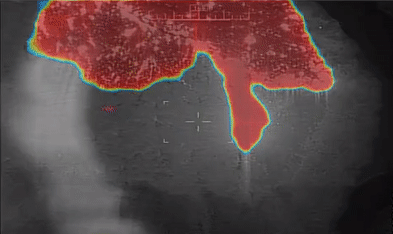The JAIC Is Supporting National Guard Efforts to Combat Destructive Wildfires
- By: JAIC

The JAIC's AI-enabled system automatically analyzes Full Motion Video captured from an aircraft sensor and records wildfire location. In this image, red-colored areas indicate active wildfire while grey regions are unburned.
"The JAIC is working to bring critical AI detection technology to the first responders who bravely battle wildfires. Increased use of AI will reduce response timelines, increase situational awareness, and save more American lives."
- Lt Gen “Jack” Shanahan, Director, Department of Defense Joint Artificial Intelligence Agency
Last year’s California wildfire season was the deadliest and most destructive in United States history. More than 8,500 fires burned across nearly 1.9 million acres in the state of California and resulted in more than $16.5 billion in damage. Cumulatively, the wildfires were the costliest natural disaster of 2018, as well as one of the deadliest. In Northern California’s Camp Fire alone, more than 85 people lost their lives. Experts predict 2019 will be another dry and difficult wildfire season.
When combatting these dangerous and fast-moving wildfires, disaster response efforts are often hindered by a lack of real-time awareness of fire-line locations. The National Guard, California Department of Forestry and Fire Protection (CAL FIRE), and local first responders need improved technology and tools to help them effectively combat deadly fires.
The Department of Defense (DoD) Joint Artificial Intelligence Center (JAIC) is working in partnership with various federal, state, and local agencies to develop an AI system that will improve the safety and efficacy of disaster response operations. These AI-enabled capabilities will help to save lives and reduce property and environmental damage.
Benefits of DoD AI Technology for Disaster Relief Operations
+ Respond to environmental and conditional changes as they occur
+ Decrease manpower and operational costs
+ Increase relief responsiveness once a federal emergency is declared
+ Better target rescue operations
+ Route responders faster
+ Deploy resources more efficiently
This fall, the JAIC team will begin field testing its Fire Line Detection AI system with the California National Guard. The system automatically detects and communicates wildfire locations in near-real time. Currently, most disaster response teams plan and respond to fire-line location information through various common operating platforms (COPs) and physically distributed paper maps. Given challenging operating conditions, firefighters and other disaster relief officials often receive new maps only once or twice a day, with each map often eight or more hours old by the time it arrives. As a result, these teams must allocate their precious resources and personnel based on information that fails to keep up with the rapidly changing situation on the ground.
The JAIC’s AI-enabled solution involves flying unmanned aircraft equipped with Full Motion Video sensors over the wildfire regions. The JAIC’s AI computer vision algorithm automatically analyzes the video data, detects regions with active wildfires, and provides near real-time fire location updates to a JAIC-developed digital map application on first responders’ mobile devices. Faster and more accurate information allows for more rapid and better-informed decision-making.
“The capability that the JAIC is providing will make a major difference in our mission this wildfire season,” said Lt Col. Thomas Keegan, California National Guard Director of Public Affairs. “AI technology will allow us to contain fires smarter and faster, and to save more lives. This Fire Line Detection Model will be a big help for the brave men and women who risk their lives to fight these wildfires” he said.
After successful testing with the California National Guard, the JAIC’s AI wildfire detection system will be made available to other National Guard units in the United States.
For more information about the JAIC and its disaster response activities contact JAIC at JAIC_Public_Affairs@mail.mil.